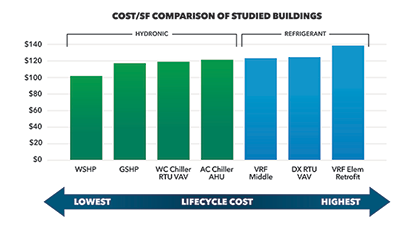Commercial building operations account for 28% of carbon emissions globally

HVAC systems contribute the largest portion of those CO2 emissions, so it is no surprise there is a focus on reducing the carbon footprint of commercial building stock.
Decarbonization solutions for building systems will evolve over time. Today the focus is away from fossil fuel to all electric solutions but there are limitations to current electric technology, and simply converting to all electric refrigerant based systems is not enough to give you the most efficient system. No single electric solution protects you from evolving regulations and can incorporate developments in new technology. This raises an important question: How can you makes sure the HVAC system technologies you choose today will meet the decarbonization challenges of the future?
WE CAN MEET THE DECARBONIZATION CHALLENGES OF THE FUTURE USING TECHNOLOGY THAT IS AVAILABLE TODAY
Hydronic systems provide the most adaptable, efficient delivery of heating and cooling regardless of the source and are already compatible with a variety of refrigerant based, thermal and electric heating and cooling sources. While new technologies often overstate their product efficiency in real world applications by as much as 50%, hydronic system efficiency is well documented in thousands of real-world installations.
Lower first cost, longer lifespan and lower operating cost combine to deliver the lowest lifecycle cost of any system.Hydronics are the ultimate open system so you’re not locked into any one manufacturer.

Bell & Gossett e-1510 end-suction pumps with Hydrovar
in the new net zero energy ASHRAE headquarters
In a recent study a range of systems were compared for a school to determine the most efficient system.
The study compared:
- Variable refrigerant flow heat pumps (VRF)
- Water source heat pumps (WSHP)
- Ground source heat pumps (GSHP)
- Direct expansion rooftop units (DX RTU)
- Water cooled chillers (WCC)
- Air-Cooled Chillers (ACC)
At the conclusion of the study hydronic systems clearly delivered the lowest cost per square foot.
Prove Hydronics to Yourself - Your Building Design with Your Costs - Modeled for Free
The Hydronics Industry Alliance has created a great self-service tool that allows you to compare the efficiency of various designs and system types.
The Building Efficiency System Tool (BEST) lets you model system designs for the most efficient system.
BEST Output - Monthly Energy Tab kilowatt consumption and fossil fuel for both heating and cooling.
- Every designer can describe a system in BEST.
- Every contractor can cost that system.
Today, cost and thermodynamics must be front and center over marketing rhetoric. The magnitude of demand is critical when evaluating electrification and decarbonization.

Water-based HVAC Systems Are Naturally:
Let us show you how hydronics can future proof your HVAC system designs for decarbonization. Hydronics are the smartest approach to future proofing your HVAC system designs for decarbonization. Contact your local Bell & Gossett Representative and learn how they can help you design the most efficient and sustainable system with Hydronics.



